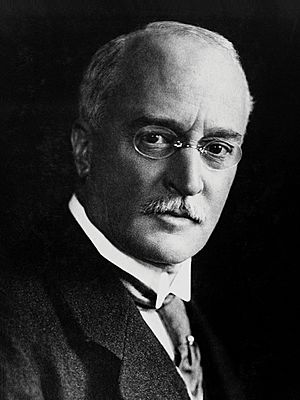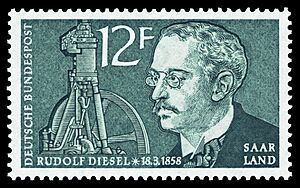Rudolf Diesel facts for kids
Quick facts for kids
Rudolf Diesel
|
|
|---|---|

Diesel c. 1900
|
|
| Born |
Rudolf Christian Karl Diesel
18 March 1858 Paris, France
|
| Died | 29 September 1913 (aged 55) |
| Resting place | North Sea |
| Nationality | German |
| Other names | Oscar Lintz |
| Alma mater | Technical University of Munich |
| Occupation | Engineer, inventor, entrepreneur |
| Employer | Sulzer, Linde, MAN AG, Krupp |
| Known for | Inventing the diesel engine |
| Spouse(s) | Martha Flasche |
| Children | 3 |
| Awards | Elliott Cresson Medal (1901) |
| Signature | |
 |
|
Rudolf Christian Karl Diesel (18 March 1858 – 29 September 1913) was a German inventor and mechanical engineer. He is famous for inventing the diesel engine, which uses diesel fuel. Both the engine and the fuel are named after him.
Contents
Early Life and Education
Rudolf Diesel was born in Paris, France, in 1858. He was the second of three children. His parents, Elise and Theodor Diesel, were German immigrants from Bavaria. His father, Theodor, worked as a bookbinder and later made leather goods.
When Rudolf was very young, he lived with a farmer family for nine months. After returning to his parents, his family faced money problems. Young Rudolf helped his father by working in his workshop and delivering leather goods. He went to a French-Protestant school and became very interested in social issues and technology.
Rudolf was a brilliant student. At age 12, he won a bronze medal for his studies. He planned to attend a special school in 1870. However, the Franco-Prussian War started that year. His family, like many other Germans, had to leave Paris. They moved to London, where Rudolf went to an English school.
Before the war ended, Rudolf's mother sent him to Augsburg, Germany. He lived with his aunt and uncle there. This helped him learn to speak German fluently. He also attended the Royal County Vocational College, where his uncle taught mathematics.
At 14, Rudolf told his parents he wanted to become an engineer. He finished his basic education at the top of his class in 1873. Two years later, he received a scholarship to the Royal Bavarian Polytechnic in Munich. He accepted the scholarship, even though his parents wanted him to start working right away.
Building a Career
One of Rudolf Diesel's teachers in Munich was Carl von Linde. Rudolf got sick with typhoid fever and could not graduate with his class in 1879. While waiting for his next exams, he worked at the Sulzer Brothers Machine Works in Winterthur, Switzerland. This gave him valuable hands-on experience.
Rudolf graduated in January 1880 with top honors. He then went back to Paris. There, he helped his former professor, Carl von Linde, build a modern refrigeration and ice plant. Rudolf became the director of this plant a year later.
In 1883, Rudolf married Martha Flasche. He continued to work for Linde and earned many patents in Germany and France.
In 1890, Diesel moved to Berlin with his wife and three children: Rudolf Jr., Heddy, and Eugen. He took charge of Linde's research and development department. He also joined several company boards. Since he could not use his patents from Linde for his own projects, he started exploring other areas.
He first worked with steam. His research into making engines more efficient led him to build a steam engine that used ammonia vapor. During tests, this engine exploded and almost killed him. He also tested high-pressure cylinders. One of these exploded during a test, sending him to the hospital for months. He had health and eyesight problems after this accident.
Rudolf Diesel had always wanted to design an engine that was super-efficient. He worked on this idea for several years. In 1892, he felt his theory was complete and received a German patent. In 1893, he wrote a book called Theory and Construction of a Rational Heat-engine to Replace the Steam Engine and The Combustion Engines Known Today. This book explained his ideas for the diesel engine. By the summer of 1893, Diesel realized his first theory had some mistakes. He then filed another patent application for his corrected ideas.
Diesel knew a lot about how heat and energy work. He understood that steam engines wasted a lot of energy, sometimes up to 90% of the fuel's power. He wanted to create an engine that used fuel much more efficiently.
In his new engine, fuel was squirted in at the end of a compression stroke. The high heat from the compression then made the fuel ignite. From 1893 to 1897, Heinrich von Buz, who ran Maschinenfabrik Augsburg, let Rudolf Diesel test and develop his engine ideas.
The first successful diesel engine, called Motor 250/400, was officially tested in 1897. You can see it today at the German Technical Museum in Munich.
Besides Germany, Diesel also got patents for his engine design in other countries, including the United States. In 1978, he was honored by being added to the Automotive Hall of Fame.
Disappearance and Death
On the evening of September 29, 1913, Rudolf Diesel boarded the Great Eastern Railway steamer SS Dresden. He was traveling from Antwerp to London for a business meeting. He had dinner on the ship and then went to his cabin around 10 p.m. He asked to be woken up at 6:15 a.m. the next morning.
However, Rudolf Diesel was never seen alive again. In the morning, his cabin was empty. His bed had not been slept in, but his nightshirt was neatly folded. His watch was left where he could see it from the bed. His hat and coat were found under the ship's back railing.
Soon after Diesel disappeared, his wife Martha opened a bag he had given her. He told her not to open it until the next week. Inside, she found 20,000 German marks in cash and papers showing their bank accounts were almost empty. In a diary Diesel had with him on the ship, a cross was drawn for the date September 29, 1913. This might have meant death.
Ten days after he was last seen, the crew of a Dutch pilot boat found a dead man in the Eastern Scheldt. They took some personal items from the man's clothes. On October 13, Rudolf's son, Eugen Diesel, identified these items as belonging to his father.
There are different ideas about what happened to Diesel. Some people think he was murdered. This is because he did not want to give the German military the only rights to use his invention. In fact, Diesel was going to London to meet with the British Royal Navy to talk about using diesel engines in British submarines. But there is not much proof for any of these ideas. His disappearance and death remain a mystery.
In 1950, Magokichi Yamaoka, who founded the Yanmar diesel engine company in Japan, learned that Diesel had no tomb or monument. Yamaoka and others decided to honor him. In 1957, for the 100th anniversary of Diesel's birth and 60 years since his engine was developed, Yamaoka donated the Rudolf Diesel Memorial Garden in Augsburg, Germany. This is where Diesel spent his childhood.
Legacy of the Diesel Engine
After Rudolf Diesel's death, his engine was improved a lot. It became a very important replacement for the old steam engines in many places. Diesel engines needed to be built stronger and heavier than gasoline engines. Because of this, they were not used much in airplanes.
However, the diesel engine became very popular in many other areas. It was used in stationary engines (engines that stay in one place), farm machines, and other off-road equipment. It also powered submarines, ships, and much later, trains, trucks, and modern cars.
Diesel engines are more fuel-efficient than other internal combustion engines used in vehicles. This means they turn more of the fuel's energy into useful work.
Rudolf Diesel was also interested in using coal dust or vegetable oil as fuel. His engine actually ran on peanut oil! While these fuels were not widely used at first, rising fuel prices and concerns about limited oil reserves have led to more use of vegetable oil and biodiesel today.
The main fuel for diesel engines is called diesel fuel. It comes from refining crude oil. Diesel fuel is safer to store than gasoline. Its flash point (the temperature at which it can catch fire) is much higher, so it is less likely to explode.
Using Vegetable Oils as Fuel
In a book he wrote, Rudolf Diesel mentioned that in 1900, a small diesel engine was shown that ran on peanut oil. He said it worked so well that "very few people were aware of the fact." This engine was made for regular oils, but it ran on vegetable oil without any changes. Diesel himself repeated these tests on a larger scale and found the results were just as good.
See also
 In Spanish: Rudolf Diesel para niños
In Spanish: Rudolf Diesel para niños
- History of the internal combustion engine
- List of German inventors and discoverers
- List of people who disappeared mysteriously at sea
- List of unsolved deaths
- Rudolf-Diesel-Medaille, German award in memory of Rudolf Diesel



